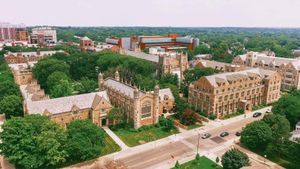A series of earthquakes has been rattling the popular Greek island of Santorini, with authorities and locals expressing growing concern as over 200 tremors have been recorded since late January. The seismic activity, which began on January 24, has triggered warnings due to its volcanic characteristics, prompting evacuation measures and heightened alert from officials as they prepare for potential larger quakes.
The earthquakes on Santorini have ranged from magnitudes of 3 to 4.8, indicating increasing seismic intensity. According to Prof. Ovgun Ahmet Ercan, a Turkish geophysicist, these earthquakes appear to be of volcanic origin, with tremors occurring at depths between 1 and 5 kilometers. He noted, "Before magma-related explosions, pressure from the magma chamber at 250 Bar could puncture the Earth's crust leading to eruptions with temperatures reaching 2,200 degrees Celsius." Such explosive volcanic activity could produce volcanic bombs and devastating sweep waves affecting the Aegean Islands, including the Peloponnese and Crete.
The Greek government has taken preventive measures, closing schools and deploying civil protection units supported by firefighters and military personnel to the area. Vasilis Kikilias, the Minister for Civil Protection, stated, "We urge citizens to strictly follow safety recommendations to minimize risk." Local officials, under Mayor Nikos Zorzos, have opened evacuation centers, emphasizing precautionary measures without causing alarm. "We are obliged to make preparations," Zorzos added. Authorities are on high alert, reminding residents to avoid crowded places and remain cautious around potential structural weaknesses.
Many locals have already evacuated, with reports of full ferries and nearly sold-out flights to Athens and Piraeus. The demand for travel has soared as people seek to leave the island, amid concerns for their safety. Since the seismic activity intensified, residents have spent nights outdoors or in their cars, anxious about potential aftershocks and volcanic eruptions. The crisis situation escalated as schools were closed on January 31 as part of the emergency response.
Despite some experts asserting the recent earthquake activity is not directly linked to the Santorini volcano, there are still significant concerns among scientists and authorities. Gerasimos Papadopoulos, a Greek seismologist, acknowledged the rising number and magnitudes of the quakes, warning, "The increased magnitude raises the risk of earthquakes." The situation remains fluid; the possibility of more severe tremors is still plausible, raising fears of the past catastrophic events like the powerful 1956 earthquakes associated with tsunamis, causing numerous fatalities and widespread damage.
The underwater volcano Kolumbos, located northeast of Santorini, has been particularly active, experiencing unprecedented levels of seismic activity, indicating possible major geological changes. Experts are reviewing historical data, noting the last significant volcanic activity on Santorini occurred between 2011 and 2012, lasting up to 14 months without resulting in explosions. Understanding the geological mechanisms at play is key as multiple plates converge beneath the islands, capable of generating strong quakes.
Local authorities are also advising residents to empty swimming pools to prevent additional hazards should significant seismic activity occur, which could destabilize structures. Safety protocols include avoiding coastal areas due to the threat of tsunamis, highlighting the urgency of adherence to disaster guidelines. Residents have been reminded to prepare emergency kits and familiarize themselves with evacuation routes to higher ground, following signs of severe tremors.
The potential for volcanic eruptions cannot be ruled out, with scientists continuing to monitor the situation closely. Authorities are prepared for possible evacuation scenarios and have set up disaster response meetings. The dramatic nature of the current seismic swarm raises curiosity as well as anxiety for many who've always viewed Santorini as paradise.
While tourism plays an important role on the island, with over 3 million visitors flocking annually to its iconic whitewashed buildings and stunning volcanic landscapes, the present circumstances challenge not only resident's lives but the local economy reliant on tourism. With the volcanic risk seen as chronic yet manageable historically, officials and scientists advocate caution but stress there is currently no immediate need for panic — nevertheless, the heightened state of readiness is prudent.
The island’s unique geomorphology makes it susceptible to tectonic shifts and is characterized by both shallow and deep underwater volcanic activity. Historical patterns show Santorini's volcano produces large eruptions approximately every 20,000 years. Its last major eruption occurred 3,000 years ago, indicating natural cycles of heightened volcanic activity. Experts remain vigilant as they analyze the most recent shifts, preparing for any eventualities.
Though conditions continue to evolve, communication between scientists, local authorities, and residents remains pivotal amid uncertainty. The development of evacuation plans and proposals for tourist safety underlines the pressing need to acknowledge Santorini's continual geological changes and possibilities, making the current situation one to monitor closely.



